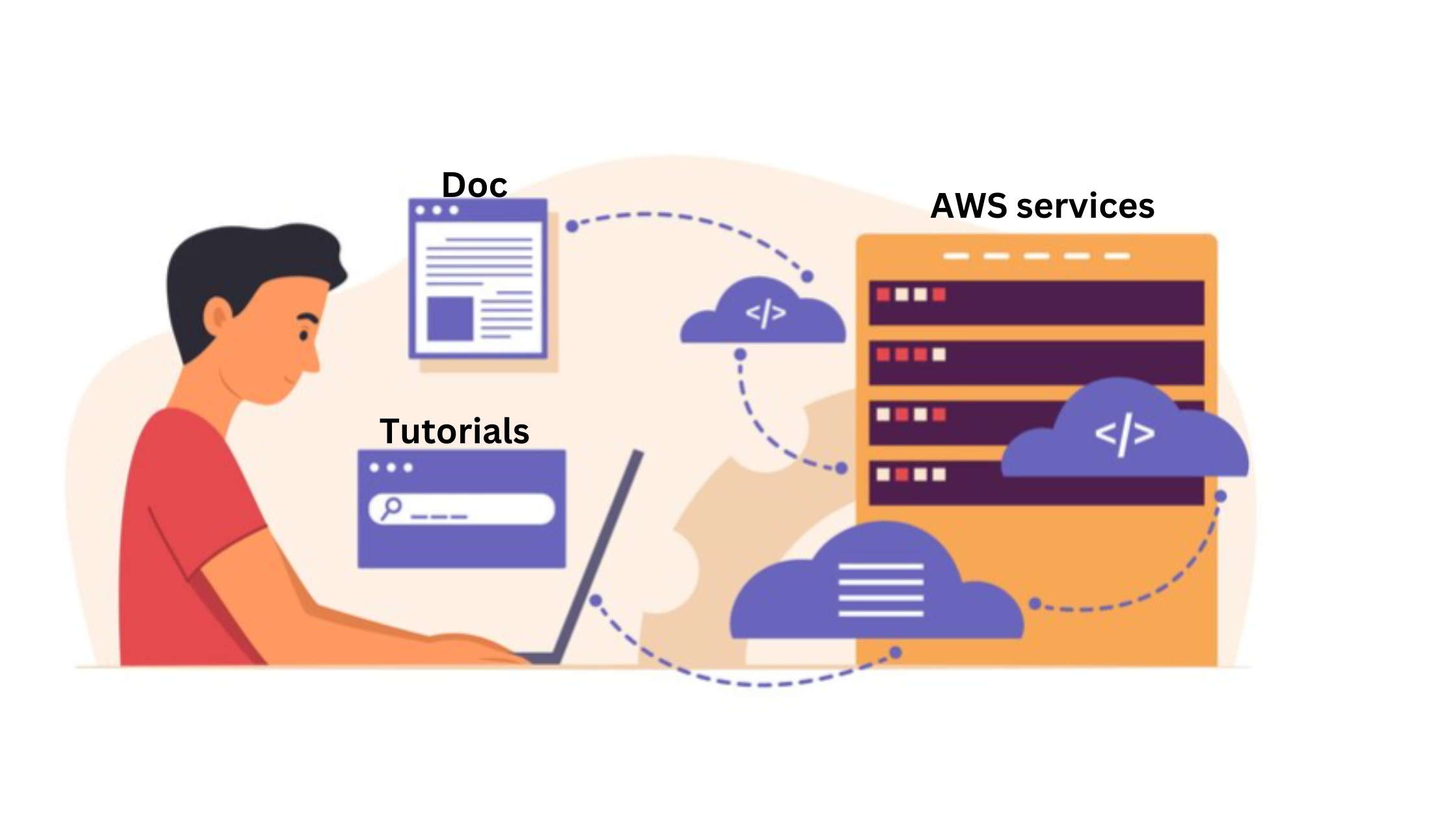Cloud computing has become an integral part of businesses worldwide. It has revolutionized the way we store, process, and manage data. Among the key players in this domain, Amazon Web Services is a leading provider, offering services tailored to meet diverse organizational requirements. In this beginner’s guide, we’ll explore:
- 1. The prominence of AWS
- 2. Its top advantages for businesses
- 3. Its core services
- 4. Steps to get started with Amazon Web Services.
What is AWS?
Amazon Web Services (AWS) is a comprehensive cloud computing platform offered by Amazon.com. Research suggests that it dominates 41.5% of the cloud computing market. Founded in 2006, AWS has become a global leader, offering over 200 services, including computing power, storage options, networking capabilities, databases, analytics tools, artificial intelligence, and machine learning solutions.
AWS enables businesses to access computing resources on demand without upfront investments in hardware infrastructure. Businesses of all sizes can access resources as needed, paying only for what they use. Millions of companies, from budding startups to established corporations and even government agencies, rely on AWS for their security, reliability, and constant innovation.

Here are some interesting statistics to note:
- 1. AWS serves over 1 million active users across 190 countries.
- 2. AWS has five times the deployed cloud infrastructure compared to the combined total of its next 14 competitors.
- 3. Amazon Web Services leads the global Infrastructure-as-a-Service sector with a 45 percent market share, as per Gartner Inc.
Benefits of choosing AWS for businesses

- Unmatched Scalability
One of the standout advantages of AWS for businesses is its unparalleled scalability. With AWS, companies can effortlessly scale their resources up or down based on demand and ensure optimal performance without over-provisioning or under-utilization of resources. This elasticity enables businesses to respond quickly to changing market conditions, accommodate sudden spikes in traffic, and efficiently manage seasonal fluctuations.
Whether a business is experiencing rapid growth or needs to adjust its operations, AWS provides the flexibility to scale computing power, storage, and other resources seamlessly. This scalability empowers businesses to focus on innovation and growth without being constrained by infrastructure limitations. This ultimately enhances agility and competitiveness in the market.
- High Cost-Effectiveness
AWS offers a pay-as-you-go pricing model that allows businesses to pay only for the resources they use. This eliminates the need for large upfront investments in infrastructure. The cost-effective approach enables businesses to optimize their IT spending, reduce operational expenses, and achieve greater financial efficiency.
Additionally, AWS provides various cost management tools and services, such as AWS Cost Explorer and AWS Budgets, to help businesses monitor and control their cloud spending effectively. Businesses can allocate their resources more strategically, reinvest savings into innovation, and achieve higher returns on investment over time.
- Complete Reliability and Security
AWS is renowned for its robust infrastructure, which is designed to deliver high levels of reliability, availability, and security. With multiple data centers located across different geographic regions, AWS ensures redundancy and fault tolerance and minimizes the risk of downtime and data loss.
Moreover, AWS offers a comprehensive suite of security services and features, including encryption, identity and access management, network security, and compliance certifications, to protect sensitive data and meet regulatory requirements. By entrusting their workloads to AWS, businesses can benefit from industry-leading security measures, proactive monitoring, and continuous updates, enhancing data protection, compliance, and trust among customers and stakeholders.
- Global Reach and Innovation
Another key advantage of AWS for businesses is its global reach and continuous innovation. With AWS’s extensive global infrastructure, businesses can deploy their applications and services closer to their customers worldwide, reduce latency, and improve user experience. Furthermore, AWS invests heavily in research and development, introducing new services, features, and capabilities at a rapid pace.
From advanced analytics and machine learning to the Internet of Things and serverless computing, AWS offers a broad range of cutting-edge technologies to drive innovation and accelerate digital transformation.
- AWS Services
As mentioned earlier as well, AWS offers a diverse range of services tailored to meet the computing, storage, database, analytics, and artificial intelligence/machine learning (AI/ML) needs of businesses across various industries.
- Compute Services
AWS provides a suite of compute services designed to deliver scalable, flexible, and cost-effective computing power. This includes Amazon Elastic Compute Cloud (EC2), which offers resizable virtual servers to run applications, process data, and host websites. EC2 instances can be customized based on performance, memory, storage, and networking requirements. It provides businesses with on-demand access to compute resources.
Additionally, AWS Lambda enables serverless computing and allows developers to run code without provisioning or managing servers. With AWS Elastic Beanstalk, businesses can easily deploy and manage web applications in the AWS cloud, while AWS Batch simplifies the process of running batch computing workloads at any scale.
- Storage Services
AWS offers a portfolio of storage services designed to store, retrieve, and manage data securely and cost-effectively. Amazon Simple Storage Service (S3) provides scalable object storage with high durability, availability, and performance, making it ideal for a wide range of use cases, including data lakes, backup and archiving, and content distribution. AWS Elastic Block Store (EBS) offers block-level storage volumes for EC2 instances and enables businesses to persistently store data and achieve low-latency access to data.
Amazon Glacier provides secure and durable long-term storage for infrequently accessed data at a low cost, while Amazon Elastic File System (EFS) offers scalable and fully managed file storage for EC2 instances and on-premises servers.
- Database Services
AWS delivers a broad range of database services to meet the diverse needs of modern applications, from relational databases to NoSQL databases and fully managed services. Amazon Relational Database Service (RDS) offers managed database instances for MySQL, PostgreSQL, MariaDB, Oracle, and SQL Server.
It simplifies database administration tasks such as provisioning, patching, and backups. Amazon DynamoDB provides a fully managed NoSQL database service that offers seamless scalability, high performance, and built-in security features, making it ideal for applications requiring fast and predictable performance at any scale. Amazon Aurora delivers a high-performance, MySQL and PostgreSQL-compatible relational database engine that combines the performance and availability of commercial databases with the simplicity and cost-effectiveness of open-source databases.
Additionally, AWS offers purpose-built databases such as Amazon Redshift for data warehousing, Amazon Neptune for graph databases, and Amazon DocumentDB for document databases, enabling businesses to choose the right database solution for their specific workload requirements and achieve optimal performance, scalability, and reliability.
- Analytics Services
AWS delivers a broad range of database services to meet the diverse needs of modern applications, from relational databases to NoSQL databases and fully managed services. Amazon Relational Database Service (RDS) offers managed database instances for MySQL, PostgreSQL, MariaDB, Oracle, and SQL Server. It simplifies database administration tasks such as provisioning, patching, and backups. Amazon DynamoDB provides a fully managed NoSQL database service that offers seamless scalability, high performance, and built-in security features, making it ideal for applications requiring fast and predictable performance at any scale.
Amazon Aurora delivers a high-performance, MySQL and PostgreSQL-compatible relational database engine that combines the performance and availability of commercial databases with the simplicity and cost-effectiveness of open-source databases. Additionally, AWS offers purpose-built databases such as Amazon Redshift for data warehousing, Amazon Neptune for graph databases, and Amazon DocumentDB for document databases, enabling businesses to choose the right database solution for their specific workload requirements and achieve optimal performance, scalability, and reliability.
- AI/ML Services
AWS also provides a comprehensive set of artificial intelligence and machine learning services to help businesses build, train, and deploy machine learning models at scale. Amazon SageMaker offers a fully managed platform for building, training, and deploying machine learning models using popular frameworks such as TensorFlow and PyTorch. AWS Deep Learning AMIs (Amazon Machine Images) provide pre-configured environments for deep learning, enabling developers to quickly get started with training models using GPU-accelerated instances.
Amazon Rekognition delivers image and video analysis capabilities, including object detection, facial recognition, and content moderation, while Amazon Polly offers text-to-speech conversion with lifelike voices. Amazon Comprehend provides natural language processing capabilities for extracting insights and relationships from text, while Amazon Translate offers neural machine translation for translating text between languages.
Simple steps to get started with Amazon Web Services
- Create an AWS Account
The first step in embarking on your AWS journey is to create an AWS account. Visit the AWS website and navigate to the “Sign Up” page. Follow the prompts to provide necessary information, including your email address, company details, and payment method. Once your account is created, you gain access to the AWS Management Console, where you can manage your resources and services.
- Understand AWS Pricing and Billing
Familiarize yourself with AWS pricing models and billing options to optimize cost management. AWS offers a pay-as-you-go pricing model, allowing you to pay only for the resources and services you use without any long-term contracts or upfront commitments. Explore the AWS Pricing Calculator to estimate your monthly bill based on your anticipated usage and resource consumption. Additionally, set up billing alerts and budgets within the AWS Billing and Cost Management console to monitor your spending and avoid unexpected charges.
- Choose Your Region and Data Center
Select the AWS region and data centre location that best aligns with your business requirements and compliance needs. AWS operates multiple regions globally, each consisting of multiple availability zones for high availability and fault tolerance. Consider factors such as latency, regulatory compliance, and data residency when choosing the appropriate AWS region for your workloads.
- Access AWS Documentation and Training Resources
Take advantage of the extensive documentation and training resources provided by AWS to enhance your understanding of cloud computing concepts and AWS services. Explore the AWS Documentation portal, which offers detailed guides, tutorials, and best practices for getting started with AWS services. Additionally, enroll in AWS training courses, webinars, and certification programs to deepen your knowledge and skills in cloud computing and AWS technologies.

- Deploy Your First Workload
Begin by deploying a simple workload or application on AWS to familiarize yourself with the platform and its capabilities. Use the AWS Management Console or AWS Command Line Interface (CLI) to provision virtual servers, storage, and networking resources as needed for your workload. Consider leveraging AWS Quick Starts, reference architectures, and deployment guides to accelerate the deployment process and ensure best practices are followed.
- Implement Security Best Practices
Prioritize security from the outset by implementing robust security measures and best practices to protect your AWS environment and data. Utilize AWS Identity and Access Management (IAM) to manage user access and permissions, enforcing the principle of least privilege. Enable encryption for data at rest and in transit using AWS Key Management Service (KMS) and AWS Certificate Manager. Implement network security controls such as security groups and network access control lists (ACLs) to restrict traffic to and from your AWS resources.
- Monitor and Optimize Performance
Continuously monitor the performance and health of your AWS resources and workloads using AWS CloudWatch, a comprehensive monitoring and observability service. Set up alarms and metrics to track key performance indicators (KPIs) and respond to any anomalies or performance issues proactively. Leverage AWS Trusted Advisor to gain insights and recommendations for optimizing costs, performance, security, and fault tolerance across your AWS environment.
Wrapping up
We hope our blog helped you understand the key concepts revolving around AWS. Here at DataCrew, we specialize in offering AWS cloud-based analytics solutions, designed to facilitate your transition to the AWS cloud and enhance your data analytics capabilities. Leveraging a suite of AWS tools and employing advanced data pipeline construction techniques, we are committed to optimizing your data to extract valuable insights efficiently. Our team is proficient in managing intricate data needs, ensuring superior performance and actionable insights tailored to your specific requirements.
Initiate a conversation with us today!